Related Research Articles

A steamboat is a boat that is propelled primarily by steam power, typically driving propellers or paddlewheels. Steamboats sometimes use the prefix designation SS, S.S. or S/S or PS ; however, these designations are most often used for steamships.
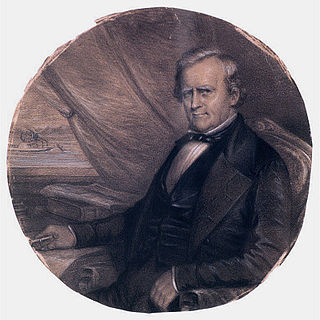
Henry Miller Shreve was the American inventor and steamboat captain who opened the Mississippi, Ohio, and Red rivers to steamboat navigation. Shreveport, Louisiana, is named in his honor.

CSS Arkansas was an ironclad ram of the Confederate States Navy named after the State of Arkansas. Arkansas is most noted for her actions in the Western Theater, when she steamed through a United States Navy fleet at Vicksburg on 15 July 1862 during the American Civil War. She was set on fire and destroyed by her crew after her engines broke down on 6 August. Her remains lie under a levee near Baton Rouge, Louisiana.
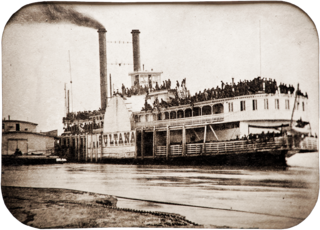
Sultana was a Mississippi River side-wheel steamboat, which exploded on April 27, 1865, killing 1,168 people in the worst maritime disaster in United States history.

Life on the Mississippi (1883) is a memoir by Mark Twain of his days as a steamboat pilot on the Mississippi River before the American Civil War. It is also a travel book, recounting his trip up the Mississippi River from New Orleans to Saint Paul many years after the war.

USS Tyler was originally a merchant ship named A. O. Tyler, a commercial side-wheel steamboat with twin stacks and covered paddles positioned aft. Constructed in Cincinnati, Ohio in 1857, it was acquired by the United States Navy, 5 June 1861 for service in the American Civil War and converted into the gunboat USS Tyler on 5 June 1861. She was commissioned in September 1861. She was protected with thick wooden bulwarks.
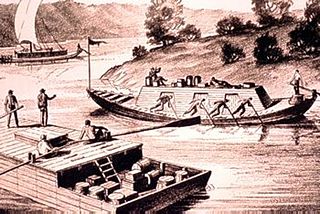
A flatboat was a rectangular flat-bottomed boat with square ends used to transport freight and passengers on inland waterways in the United States. The flatboat could be any size, but essentially it was a large, sturdy tub with a hull.
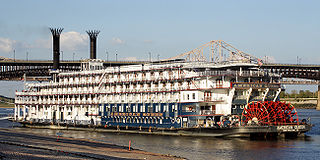
American Queen is said to be the largest river steamboat ever built. The ship was built in 1995 and is a six-deck recreation of a classic Mississippi riverboat, built by McDermott Shipyard for the Delta Queen Steamboat Company. Although the American Queen's stern paddlewheel is indeed powered by a steam plant, her secondary propulsion, in case of an emergency and for maneuverability around tight areas where the paddle wheel can not navigate, comes from a set of diesel-electric propellers known as Z-drives on either side of the sternwheel. She has 222 state rooms for a capacity of 436 guests and a crew of 160. She is 418 feet (127 m) long and 89 feet (27 m) wide.
CSS Colonel Lovell was a cotton-clad ram of the Confederate States Navy during the American Civil War

Natchez has been the name of several steamboats, and four naval vessels, each named after the city of Natchez, Mississippi or the Natchez people. The current one has been in operation since 1975. The previous Natchez were all operated in the nineteenth century, most by Captain Thomas P. Leathers. Each of the steamboats since Leathers' first had as its ensign a cotton bale between its stacks.

USS Dick Fulton was a 123-ton stern-wheel steamer used as an auxiliary vessel in the United States Ram Fleet during the American Civil War.

Steamboats on the Columbia River system were wrecked for many reasons, including striking rocks or logs ("snags"), fire, boiler explosion, or puncture or crushing by ice. Sometimes boats could be salvaged, and sometimes not.

En remontant le Mississippi is a Lucky Luke comic written by Goscinny and Morris. It is the sixteenth title in the Lucky Luke Series. The comic was printed by Dupuis in 1961 and by Cinebook in English in 2021 as Steaming Up the Mississippi. Both Goscinny and Morris were avid readers of frontier tales and particularly Mark Twain books. This album is culturally significant as it is connected with Mark Twain's experience as a Mississippi steamboat pilot before the American Civil War.

New Orleans was the first steamboat on the western waters of the United States. Owned by Robert Fulton and Robert R. Livingston, and built by Nicholas Roosevelt, its 1811–1812 voyage from Pittsburgh, Pennsylvania, to New Orleans, Louisiana, on the Ohio and Mississippi rivers ushered in the era of commercial steamboat navigation on the western and mid-western continental rivers.
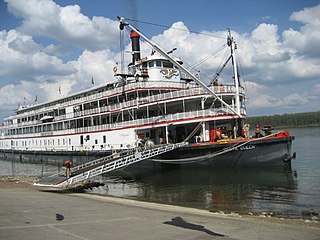
Steamboats played a major role in the 19th-century development of the Mississippi River and its tributaries by allowing the practical large-scale transport of passengers and freight both up- and down-river. Using steam power, riverboats were developed during that time which could navigate in shallow waters as well as upriver against strong currents. After the development of railroads, passenger traffic gradually switched to this faster form of transportation, but steamboats continued to serve Mississippi River commerce into the early 20th century. A small number of steamboats are used for tourist excursions into the 21st century.

M/V Mississippi is a United States Army Corps of Engineers (USACE) towboat operating on the Mississippi River. It is the largest diesel towboat on the river.

The Lucy Walker steamboat disaster was an 1844 steamboat accident caused by the explosion of the boilers of the steamboat Lucy Walker near New Albany, Indiana, on the Ohio River. The explosion occurred on the afternoon of Wednesday, October 23, 1844, when the steamer's three boilers exploded, set the vessel on fire, and sank it. It was one of a number of similar accidents of early 19th-century riverine transportation that led to important federal legislation and safety regulations. The vessel's owner was a Native American; her crew were African-American slaves, and her passengers represented a cross-section of frontier travelers.

Grant Marsh was a riverboat pilot and captain who was noted for his many piloting exploits on the upper Missouri River and the Yellowstone River in Montana from 1862 until 1882. He served on more than 22 vessels in his long career. He started his career in 1856 as a cabin boy and continued his career for over 60 years becoming a captain, riverboat pilot and riverboat owner. During his career he amassed an outstanding record and reputation as a river steamboat pilot and captain. His piloting exploits became legendary and modern historians refer to him as "Possibly the greatest steamboat man ever", "possibly the greatest [steamboat pilot] ever", "possibly the finest riverboat pilot who ever lived", "the greatest steamboat master and pilot on both the Missouri and Yellowstone Rivers"
Horace Ezra Bixby was a steamboat pilot on the Mississippi-Missouri-Ohio river system from the late 1840s until his death in 1912. Bixby is notable in his own right for his high standing in his profession, for his technical contributions to it, and for his service in the American Civil War. However, he is best known for having had as his "cub pilot" the young man known to him as Sam Clemens, later to become famous under his pen name as American author Mark Twain. Twain's descriptions of Bixby's character and pedagogic style form a good part of his memoir Life on the Mississippi, and it was through this medium that Bixby—much to his annoyance—became well-known beyond the circles of his family, friends and profession.

The Island Queen was a series of two American sidewheeler steamboats built in 1896 and 1925 respectively. Both vessels were passenger carriers cruising along the Mississippi and Ohio rivers as both an excursion boat and tramp steamer. The first Island Queen burned in 1922 in a fire which destroyed several other vessels. The second Island Queen was destroyed in 1947 when its Chief Engineer, using a welding torch, accidentally cut into her fuel tank. The Island Queen was reduced to its steel frame. The boat was scrapped by a local company.
References
- ↑ "THE EXPLOSION OF THE PENNSYLVANIA". The New York Times. 1858-06-16. Retrieved 2008-03-20.CS1 maint: discouraged parameter (link)
- ↑ "CAUSE OF THE EXPLOSION OF THE PENNSYLVANIA". The New York Times. 1858-06-26. Retrieved 2008-03-20.CS1 maint: discouraged parameter (link)
- ↑ Hon. Jere A. Brown, Cleveland Gazette (Cleveland, Ohio), April 5, 1913, Page 3
Coordinates: 34°39′34″N90°28′50″W / 34.659440°N 90.480675°W